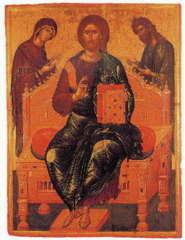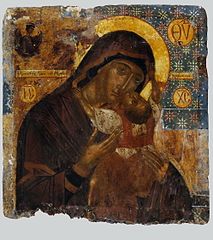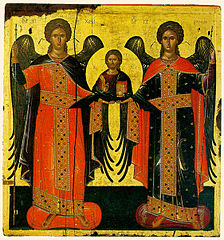art.wikisort.org - Artist
Angelos Akotantos (Greek: Άγγελος Ακοτάντος 1390-1457) was a Greek painter, educator, and protopsaltis. He painted in the Byzantine style or maniera greca. He represented the transition from the Byzantine style of painting to the more refined Cretan School. Angelos's students were Andreas Pavias, Andreas Ritzos, and Antonios Papadopoulos. He influenced the future artists of the Cretan School, namely Georgios Klontzas, Theophanes the Cretan, Michael Damaskinos and El Greco. Angelos's brother Ioannis Akotantos was also a famous painter. There are 50 paintings all over the world by Akotantos. Thirty are signed and twenty have been reliably attributed to the artist.[1][2][3][4][5]
Angelos | |
|---|---|
| Born | 1390 Crete, Republic of Venice |
| Died | 1457 Heraklion, Republic of Venice |
| Nationality | Greek |
| Known for | Iconography and hagiography |
| Notable work | The Virgin Cardiotissa, The Congregation of the Archangels, Sts Peter and Paul, Deisis, St. Phanourios killing the Dragon |
| Movement | Cretan School |
| Spouse | Eleni Marmara |
| Years active | 1425–1457 |
| Era | 15th century |
| Style | Maniera Greca |
History
Angelos Akotantos was born in Crete. He had a sister and two brothers; one of the latter was the famous painter Ioannis Akotantos. Much information about Angelos's life is drawn from the will he composed in 1436, in advance of a planned journey to Constantinople. The document is now housed in the State Archives of Venice.[6] At the time of writing, Angelos was married to Eleni Marmara and they were expecting their first child. He was relatively wealthy with a significant number of possessions.[7]
Angelos enjoyed a high level of education—as demonstrated by his ability to write his own will—and owned a big and valuable library. He specified that if his child died young the books in this library should be sold and the money raised should go to charities of his choice. Alongside his painting activities, he was a chanter and teacher of music; the Venetian authorities appointed him protopsaltis (first chanter), an honorable position carrying a government salary.[8]
He was familiar with the monastic superior of Saint Phanourios at Versamonero, and the will grants the institution a sum of money to hold memorial services after his death. He also had a relationship with the monastery of Saint Catherine, leaving them an icon of the eponymous saint.[9]
Akotantos's paintings are extremely popular and his style has been copied by many icon painters. Copies of his paintings can be found in churches and private collections all over the world namely Greece. One church that exhibits a copy of an Akotantos painting is the Church of St. Symeon, Mytilene. They have Saint Anne with the Virgin.[10]
Akotantos was one of the most important Greek painters of the first half of the 15th century. The center of Byzantine art was transferred from the capital of the Constantinople to Heraklion because of the fall of Constantinople in 1453. He supplied icons to Greek churches and monasteries on Crete, Patmos, Rhodes, and elsewhere. Akotantos painted icons of Saint Phanourios killing the dragon, similar to Saint George, a local tradition found in the icons of the 15th century in Crete. Many scholars believe that the famous painter Angelos who is responsible for countless paintings is actually Akotantos. He inspired countless painters and most of his work is emulated even today.[11][12]
Gallery
 The Virgin and Child
The Virgin and Child- The Virgin Cardiotissa
- The Virgin and Child
- Saint Fanourious
- St George on Horseback, Slaying the Dragon
- St George
- Congregation of the Archangels
- John the Baptist
 Tree of Jesus
Tree of Jesus Jesus, Mary, and Saint John
Jesus, Mary, and Saint John- Jesus by Angelos
 Christ Enthroned
Christ Enthroned Christ Enthroned
Christ Enthroned
Notable works
See also
- Hagiography
- Iconography
- Michael Damaskenos
- Nikolaos Lampoudis
References
- Richardson, Carol M. (2007). Locating Renaissance Art. United Kingdom: Yale University Press. p. 200.
- Achimasto Patamianoy, Mirtali (1991). Two Paintings of Andreas Ritzos and Angelos Akotantos at the Byzantine Museum (PDF). Athens GR: Journal of the Christian Archaeological Society. p. 118.
- Icon of the Mother of God and Infant Christ (Virgin Eleousa), c. 1425-1450 attributed to Angelos Akotantos (Greek, c. 1450) at the Cleveland Museum of Art
- Byzantium's Artistic Legacy Mark Rose. Archaeological Institute of America. 7 November 2002. Retrieved 7 April 2016.
- Eugenia Drakopoulou (January 4, 2022). "Angelos (1) or Angelos Akotantos". Institute for Neohellenic Research. Retrieved January 4, 2022.
- C. M. Richardson, K. Woods, M. W. Franklin, "Renaissance art reconsidered: an anthology of primary sources" Google Books
- Richardson, 2007, p. 178
- Richardson, 2007, p. 178
- Richardson, 2007, p. 178
- Richardson, 2007, p. 178
- Icon of the Mother of God and Infant Christ (Virgin Eleousa), c. 1425–1450 attributed to Angelos Akotantos (Greek, c. 1450) at the Cleveland Museum of Art
- M. Vassilaki, "The Painter Angelos and Icon-Painting in Venetian Crete", Farnham 2009
External links
 Media related to Angelos Akotantos at Wikimedia Commons
Media related to Angelos Akotantos at Wikimedia Commons- List of works of art shown in the exhibition "Byzantium: Faith and Power (1261–1557)", The Metropolitan Museum of Art, New York, March 23 – July 4, 2004.
- Article in the newspaper Kathimerini
- Byzantium: faith and power (1261–1557), an exhibition catalog from The Metropolitan Museum of Art (fully available online as PDF), which contains material on Akotantos
На других языках
- [en] Angelos Akotantos
[es] Angelos Akotantos
Angelos Akotantos (en grafía griega Άγγελος Ακοτάντος) fue hagiógrafo y pintor bizantino del siglo XV, activo en Heraklion (Creta), por entonces perteneciente a la Serenísima República de Venecia. Fue el primero en firmar sus iconos con su nombre ("Χειρ Αγγέλου" -"por la mano de Angelos"-).[4] Se le considera el más importante de los pintores bizantinos de su época, cuando Constantinopla, el centro político del decadente Imperio, asediada por los turcos (cayó en 1453), cedió su posición como centro artístico.[5][it] Angelos Akotantos
Angelos Akotantos (in greco Άγγελος Ακοτάντος; ... – Candia, 1450) è stato un pittore greco e agiografo.Другой контент может иметь иную лицензию. Перед использованием материалов сайта WikiSort.org внимательно изучите правила лицензирования конкретных элементов наполнения сайта.
WikiSort.org - проект по пересортировке и дополнению контента Википедии












